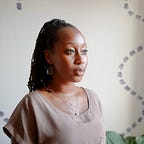Fill the Gap Berlin: The First European Contemporary Art Biennale Curated by All Black Curators
*After the demolition of the Berlin Wall began in 1989, some protesters chanted “Fill the gap!” as they attempted to put up a styrofoam replica of part of the wall.
This year 46 local and international artists will be featured in the scaled-down 10th Berlin Biennale curated by the South African curator Gabi Ngcobo. Along with Yvette Mutumba, Nomaduma Rosa Masilela, Serubiri Moses and Thiago de Paula Souza, Ngcobo will present We Don’t Need Another Hero. Having opened last Saturday, June 9th, this year’s Biennale of Contemporary Art draws its name from Tina Turner’s 1985 song, which came at “a moment directly preceding major geopolitical shifts that brought about regime changes and new historical figures” in Berlin — it says on their website.
While a different Berlin exists now, the city is always in conversation with its past, present, and future as well as with the larger country of Germany and on a global scale. Today Berlin grapples with issues of integration, gentrification, and the rise of the far-right. Though, the biennale description promises that it “does not provide a coherent reading of histories or the present of any kind. Like the song, it rejects the desire for a savior.”
However, with five Black curators from the diaspora (South Africa, Brazil, Uganda, the United States and the Netherlands), it is clear that post-colonial and Black/African perspectives will be centralized. In an interview with Kate Brown for Art News, Ngcobo says: “we’re in conversation with Berlin as a city in Europe and as a city in the world. There are also a lot of events foregrounding urgent topics that are happening in Berlin right now and the time seems to be really ripe for post-colonial and decolonizing discourses.” Considering that after documenta, the Berlin Biennale is the second biggest event in Germany it is significant and future-forward to have curators of African descent.
documenta was conceived in 1955 by painter and professor Arnold Bode to bring Germany back in conversation with the rest of the world through art after the atrocities and damage caused by World War II. Post World War II was a time when European countries were negotiating their violent relationships with other parts of the world and decolonization brought more Africans and South Asians to Europe.
To have the faces of the Berlin Biennale be Black faces not only acknowledges that the demographics of Germany have been changing and will continue to change, but also that there are Black people in the past, present and future of Europe who are potential architects of the culture and art in these cities. It is not only people who are postcolonial, but the continent of Europe itself.
The biennale will take place at four permanent exhibition venues around Berlin: Akademie der Künste at Hanseatenweg, KW Institute for Contemporary Art, Volksbühne Pavilion, and ZK/U — Center for Art and Urbanistics. Featured artists include Iranian Sam Samiee, South African multimedia artist Dineo Seshee Bopape, and British-Tanzanian artist Lubaina Himid — to name a few. This year’s biennale has art and artists from Pakistan to Cuba, necessarily bringing in marginalized subjectivities and conversations about who belongs and who does not. Centralizing art from Africa and by other post-colonial communities challenges hegemonic notions of knowledge and power, which are often perpetuated in Western cities especially through art and culture.
While White women curators are still being hired to curate African art, even though they are overrepresented in the curation of African & African Diaspora art in European and American museums and galleries, it is refreshing to see this biennale headed by a South African woman and a team of Black curators. Especially when art and cultural institutions claim it is difficult to find Black curators. This is the first biennale curated by a person from Africa and is the first European biennale ever curated entirely by Black curators. It’s no surprise its taking place in Berlin, a city that has always been a hub for a subaltern, alternative, and clandestine arts and cultural scene.
By presenting other ways of seeing and being at the Berlin Biennale, Blackness is not a limit but rather an asset. Although the curators of We Don’t Need Another Hero are rather elusive when it comes to over-simplified titles or purely racial identifications, the exhibition seems to be critical in taking a more complex look at who is important and who is left out in history, archives, and the collective memories of important places in the European city.
Black/African and postcolonial people have been largely excluded or invisibilized in European history and culture for centuries, yet now our perspectives inform contemporary art and the future of European cities. The 10th Berlin Biennale exhibition is sure to be complex, fantastical, and worldly because the curators are Black, and in-spite of their Blackness. Maybe the Berlin Biennale will inspire others to see the expansiveness and adaptability of a Black diasporic perspective.
